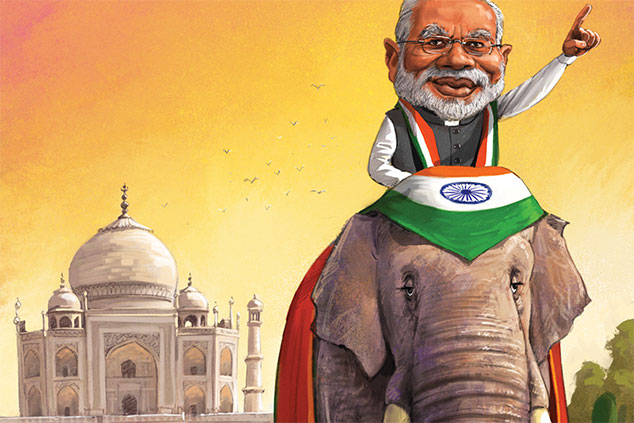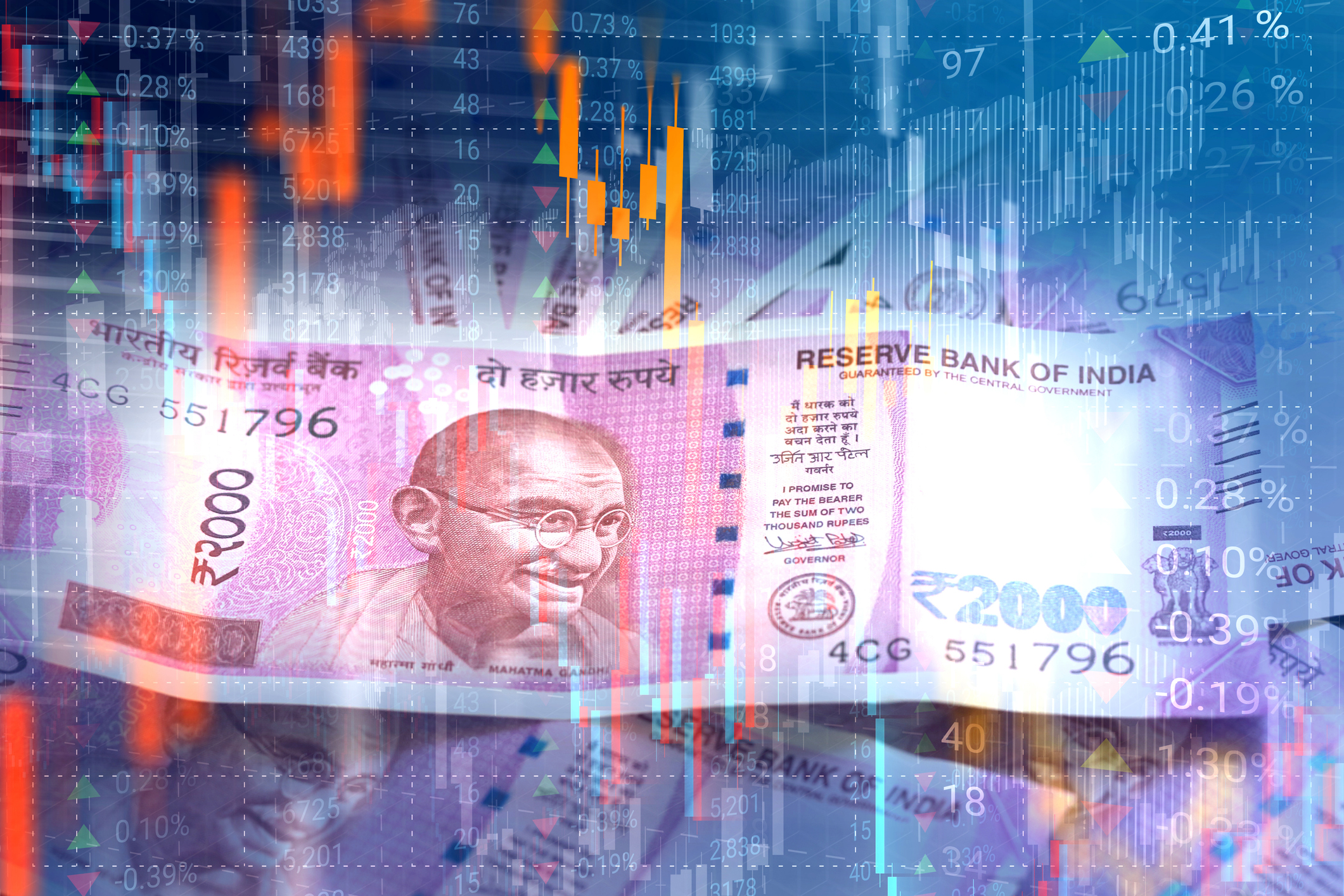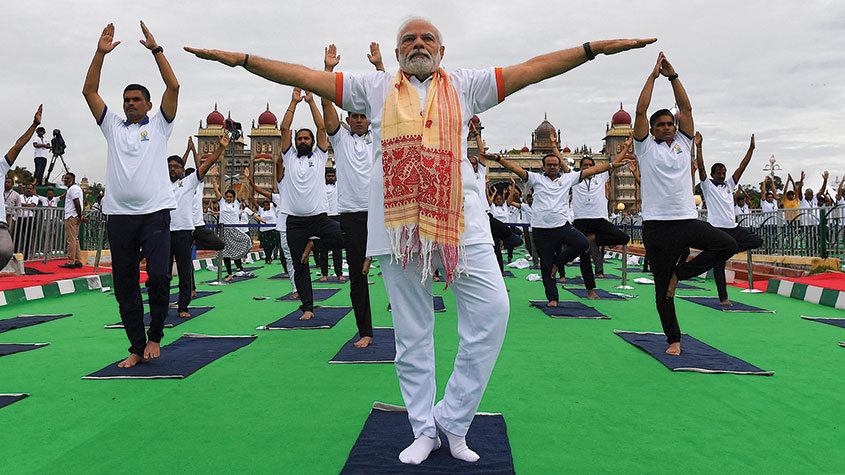Modi’s magic will power India for years to come
India looks ready to fulfil its long-term potential, says Rupert Foster. And Cris Sholto Heaton examines short-term risks in the financial sector and highlights the best investment trusts.


India looks ready to fulfil its long-term potential, says Rupert Foster, while Cris Sholto Heaton examines short-term risks in the financial sector and highlights the best investment trusts.
India is a vast patchwork of languages, ethnicities and cultures with 1.3 billion people spread over three million square kilometres. One of its 29 states is Gujarat, which by 2014 had become an emblem of economic liberalisation in a country making little overall progress in this direction. In May of that year Narendra Modi, who had been Gujarat's chief minister for 13 years, won a national election with his BJP Party, replacing the Congress Party, which had led India for a decade.
Local and global investors, hoping Modi would replicate his success with Gujarat at the national level, piled into equities. Mumbai's Sensex index rose by 50% in 2014. Foreign investors have continued to flock to India since then, counting on structural reform to cement rapid and sustainable growth. India has indeed made impressive progress in the past few years, and is on track to oust the UK from its position as the world's fifth-biggest economy this year. It is now contributing as much to world GDP growth as the UK, France and Germany combined.
MoneyWeek
Subscribe to MoneyWeek today and get your first six magazine issues absolutely FREE

Sign up to Money Morning
Don't miss the latest investment and personal finances news, market analysis, plus money-saving tips with our free twice-daily newsletter
Don't miss the latest investment and personal finances news, market analysis, plus money-saving tips with our free twice-daily newsletter
However, 2018 has not been a good year for emerging markets. The Indian rupee has slipped by 15% against the US dollar this year and Indian stocks are down 10%. In addition, the next national election takes place in May 2019. Currently, opinion polls point to Modi keeping his majority but with much reduced size. Will the Indian government start handing out economic bribes, such as further subsidies on ever more expensive oil, as it has in the past?
If so, will such policies knock India off course, or have the reforms of the last few years established an enduring virtuous circle fuelled by a vast cheap workforce with wonderful demographics, an excellent education system, solvent banks and the productivity improvements that technology will bring? Now seems a good time to reassess the outlook.
Growth may slow for now
Let's start with the economic backdrop. GDP expanded at an eye-watering annual pace of 8.2% in the second quarter, the fastest growth in the region. However, there are some signs of shorter-term concerns. The budget deficit is forecast to be 3.8% this year and core inflation rose to 5.8% year-on-year in August. The Reserve Bank of India has raised its main interest rate by 0.5% to 6.5% this year and another 0.5% rise is expected before the end of the year. The currency has stabilised in the last couple of months, thus providing some respite. However, there are fears that this year's interest-rate hikes will cap economic activity into 2019. With the fiscal deficit already at 3.8% this year, if Modi dips into the government's coffers to hand out pre-election sweeteners to the electorate, bond yields may continue to drift higher, putting more pressure on the economy.
The reforms so far
On the positive side of the ledger, however, are the various measures Modi has implemented to improve the long-term outlook. Most observers agree that India's economy has been overshadowed by the rest of the region in recent decades owing to permanently weak government finances, endemic corruption and a morass of regulation that hampers business at every turn. On government finances Modi has done two things. Firstly, he finally got a Goods and Services Tax (GST), the equivalent of our VAT, through parliament. India's tax take is abysmally low even by Asian standards and this new GST will alleviate the immediate stress. Secondly, Modi and Arun Jaitley, his finance minister, have hitherto broken with their predecessors' policy of electoral bribery by reducing subsidies on fuel prices. They have been aided in their fiscal resolution by the attitude of the Reserve Bank of India, which wants to keep inflation under wraps and has been hawkish on interest rates. However, governments always face a balancing act between short-term growth and prudence. The last governor of the Reserve Bank, Raghuram Rajan, is believed to have been pushed out by Modi after erring too far towards the latter (see page 26 for more on this topic).
Taking on the shadow economy...
Modi's demonetisation strategy has been the cornerstone of his battle against corruption. The government withdrew two large-denomination bank notes overnight in a major crackdown on the shadow economy, which depended heavily on them. This damaged the economy in the short run and hurt many small businesses, but it signalled that nefarious activities were now fair game. A further benefit of demonetisation is that it has rapidly accelerated the adoption of the e-payments industry in India. In a country where the vast majority of the population is unbanked, e-payments are sweeping in. This will encourage Indians to take up other technologies rapidly and help tackle the famously heavy-handed bureaucracy that has held business back for decades.
Another key element of the battle against graft is the ongoing movement to a national online payments infrastructure. It has restricted the ability of the vast low-level government apparatus to strip government benefits from people they are aimed at. This policy was started under the last Congress government, but Modi has carried it forward.
... vested interests...
Modi has also done much to dismantle the cobweb of government regulation. Here the real battle is conducted against the firmly entrenched historical interest groups who have always funded Indian politics to allow their interests to be protected. A key development in this context is tackling the misuse of deposit payments in the real-estate industry. These should have been used to fund the development of new buildings, but instead they were often funnelled into new land acquisitions for the developer to facilitate the accumulation of more deposit payments. Modi's new real-estate laws have stopped this practice and should restore retail investors' confidence in this key industry.
... and the banking system
A solvent banking system is crucial to faster long-term growth. India has a vibrant private-banking sector, but most banking is still conducted by inefficient state-owned operators, which have amassed too much bad debt. On the surface Modi has failed to reform this key sector. Some foreign investors would have hoped for large bad-debt writedowns, but so far we have only seen piecemeal improvement. Until recently it has generally been impossible for banks to put failing customers into insolvency and bring to an end these zombie entities. But Modi's government finally got a Banking Insolvency Act into law and we have seen 32 businesses pushed into bankruptcy since. State banks have fewer reasons now not to take action to bring bad debts to light and cauterise the wound.
There is much more Modi needs to do. Boosting spending on infrastructure would make sense. Gross fixed-capital formation (GFCF), or investment spending, has fallen from 36% of GDP in 2008 to 28.5% in 2018. Note, however, that India is already constructing 133km of motorway a day, up from 73km five years ago. In the more backward areas of India, which account for much of the country, this very basic infrastructure improvement can have a dramatic effect on output. Note that even with interest rates rising the economy accelerated in the second quarter.
A compelling investment
This is the core of the long-term bull case for India. The country has low productivity but good demographics (half the population is under 25), while there are now marginally better controls on corruption and more business-friendly policies. The upshot is that the economy cannot fail to grow at a highly accelerated rate even with only a relatively small amount of base infrastructure spending. In any case, private-sector infrastructure spending in India is already showing signs of a new concerted boom.
There is, then, ample scope for fast growth in future. That is why all large foreign global multinationals know that India is the only country left in the world that will "move the dial". For Amazon, Apple, Google, Walmart, Microsoft and Facebook, India is the key to their medium-term growth outlook. Two, Google and Microsoft, have Indian CEOs.
Walmart recently invested $20bn in its Indian business by buying ecommerce retailer Flipkart. The others will all follow this level or more of investment. They will also get significant competition from leading Chinese companies, such as Alibaba and Tencent. India is the global battleground for all global companies. Expect dramatic levels of overinvestment by these businesses as they strive to get an edge. This will be to the benefit of the Indian economy and people if rather to the detriment of the shareholders of those leading global companies.
Modi's magic should endure
Investment in India remains a vote of confidence in Narendra Modi. The extent to which he may give in to populist temptation in the run-up to the election and after it is unclear. However, India has made enough structural changes in the last five years and the benefits of technology are starting to catalyse enough economic activity to make continued economic growth a strong likelihood. Even if Modi loses complete control of parliament it would appear highly likely that his pro-growth policies will continue in a strong enough form to allow progression. The market trades at its average valuation on a ten-year view.We may well see further weakness in the short term as emerging-market turbulence endures and next May's election will rattle markets. But long-term investors will feel that we have reached another good entry point. I would firmly agree with this view.
India's big central-bank bust-up

By Cris Sholto Heaton
Narendra Modi has already pushed out one Reserve Bank of India (RBI) governor: in 2016, Raghuram Rajan was replaced after a single term by Urjit Patel, who was widely seen as being more willing to do the government's bidding. While Rajan is known to have opposed Modi's decision to withdraw most banknotes from circulation as part of a crackdown on the black economy, Patel defended the move (subsequent analyses including those from the central bank have concluded that the scheme did not achieve its main goal, and also hurt both growth and unemployment). But now the likelihood is growing that Patel is on his way out for opposing Modi's efforts to shore up growth temporarily ahead of the election.
There are three main areas of contention, two of which involve the RBI's attempts to keep the banking system safe at a time when the government's priority is to keep credit flowing. First, there's the long-standing problem of bad loans in state-controlled banks, known as public sector undertaking (PSU) banks. After being too lax about the scale of the problem for years, the RBI brought in tougher regulation earlier this year, in an effort to bring it under control. Many of these loans have been made to well-connected businessmen who face losing control of their business if their debts are not rolled over. So they have been lobbying the government to make the RBI back off.
Second, there's the crisis in non-banking financial companies (NBFCs), India's shadow-banking sector. These were responsible for around one-third of credit creation last year and a greater share of consumer finance and small-business lending. NBFCs rely heavily on short-term financing from banks and mutual funds, rather than deposits or long-term debt. And since Infrastructure Leasing & Finance Services (IL&FS), a large infrastructure-focused NBFC, defaulted in September, lenders have become less keen to extend finance to NBFCs. Some major NBFCs are reportedly facing significant cash-flow problems, so the government wants the RBI to provide them with more short-term financing directly or to allow PSU banks to lend more freely to them. The RBI argues that the situation is not serious enough to justify special measures that would be open to misuse.
The third dispute is about control of the central bank's reserves. The government wants the RBI to hand over some of these to the government to help plug gaps in the public finances, so that it can keep spending freely in the run-up to the elections. The RBI isn't keen on the idea; its supporters argue that holding substantial reserves is important for maintaining confidence in the central bank.
This dispute has now become very messy. The government has begun consulting on invoking its power under the act that created the RBI to "from time to time give such directions to the bank as it may, after consultation with the governor of the bank, consider necessary in the public interest" (a power that has never been formally used). There is speculation that Patel will resign if this happens and that Modi wants him gone in any case.
From a long-term perspective, the RBI is in the right. India would benefit from cleaning up cronyism and bad debts, even if the consequences would be tighter credit conditions and slower growth in the short term. Still, it probably doesn't make much difference to India's immediate prospects who wins this spat, so long as the global economy remains in reasonable shape. But in a wider downturn, issues such as the state of the PSU banks, the credit crunch in the NBFC sector and concerns about policymaking will almost certainly hurt the local market. So while there's certainly plenty to be optimistic about in India, investors need to watch these risks.
One to buy and one to watch
Individual foreign investors can buy Indian stocks, but it's a highly bureaucratic process and few people can be bothered. Unfortunately, the selection of Indian stocks listed on foreign exchanges is limited and doesn't give you access to many of the most promising sectors. So this is a market where most people are best served by buying an investment trust.
There are two obvious candidates, depending on your view of the economic outlook. Aberdeen New India Investment Trust (LSE: ANII) holds a diversified portfolio of mostly larger, high-quality companies (it has around 23% of the portfolio in financials, for example, but these are groups such as HDFC and Kotak Mahindra Bank, rather than PSU banks or those that are likely to be hit by problems in the NBFC sector). It has reasonable charges for a fund in this sector (ongoing charges of 1.25% last year) and trades at a discount to net asset value of 14.5% (compared with a five-year average of 11.5%). This is the steady choice and would be the best pick if you wanted to invest in India now.
Alternatively, the India Capital Growth Fund (LSE: IGC) is weighted towards smaller firms (almost 60% of the portfolio is in stocks with a market cap of under $2bn), which may deliver stronger returns over the long term. The fund's share price is up 138% over the past five years, compared with 94% for Aberdeen New India (and 84% for the large-cap focusedJP Morgan Indian Investment Trust (LSE: JII), the third main trust in the sector).
But the kind of investments it holds are likely to be more volatile, as recent news has shown: they include Dewan Housing Finance, which was caught up in the sell-off of NBFCs in the wake of the default of IL&FS, as well as Yes Bank, which slumped around the same time after the RBI forced it to change its chief executive over concerns that Yes has been understating problems with bad loans. A fund like this is often good for taking full advantage of a boom, but at this point I would wait to see how India's financial-sector wobbles and the wider global jitters play out before buying. A discount to net asset value of 12.5% doesn't look like an obvious opportunity either, compared with its five-year average of 16.8%. The fund has an ongoing charge of 1.87%.
Get the latest financial news, insights and expert analysis from our award-winning MoneyWeek team, to help you understand what really matters when it comes to your finances.
Rupert is an investment strategist and adviser at J & C Foster, providing Asian, Consumer and Global Equities Strategy advice to a number of family offices and portfolio management organisations. He writes on Asia and Global Macroeconomics for a number of investment publications including MoneyWeek and HL Investment Times.
-
 5 investment trusts for your pension
5 investment trusts for your pensionInvestment trusts are often a good choice for long term growth and income options, but which ones should you consider for your pension?
-
 Inheritance tax climbdown as agricultural property relief threshold raised
Inheritance tax climbdown as agricultural property relief threshold raisedReforms to agricultural property relief had sparked strong opposition, and the government has now diluted its controversial inheritance tax plans for farmers
-
 Modi’s reforms set Indian stocks on fire
Modi’s reforms set Indian stocks on fireIndian stocks pass a new milestone, but global fund managers are holding back. Are there signs of overheating?
-
 Invest in space: the final frontier for investors
Invest in space: the final frontier for investorsCover Story Matthew Partridge takes a look at how to invest in space, and explores the top stocks to buy to build exposure to this rapidly expanding sector.
-
 Invest in Brazil as the country gets set for growth
Invest in Brazil as the country gets set for growthCover Story It’s time to invest in Brazil as the economic powerhouse looks set to profit from the two key trends of the next 20 years: the global energy transition and population growth, says James McKeigue.
-
 Shining a light on India
Shining a light on IndiaAdvertisement Feature Despite some short-term challenges, India remains very attractive for investors. Here’s why.
-
 5 of the world’s best stocks
5 of the world’s best stocksCover Story Here are five of the world’s best stocks according to Rupert Hargreaves. He believes all of these businesses have unique advantages that will help them grow.
-
 The best British tech stocks from a thriving sector
The best British tech stocks from a thriving sectorCover Story Move over, Silicon Valley. Over the past two decades the UK has become one of the main global hubs for tech start-ups. Matthew Partridge explains why, and highlights the most promising investments.
-
 Could gold be the basis for a new global currency?
Could gold be the basis for a new global currency?Cover Story Gold has always been the most reliable form of money. Now collaboration between China and Russia could lead to a new gold-backed means of exchange – giving prices a big boost, says Dominic Frisby
-
 India’s economy has come a long way in 75 years, but where next?
India’s economy has come a long way in 75 years, but where next?Briefings India has come a long way since independence to become the world's fifth-largest economy. But early mistakes and now a divisive leader are holding back the economy’s potential.
